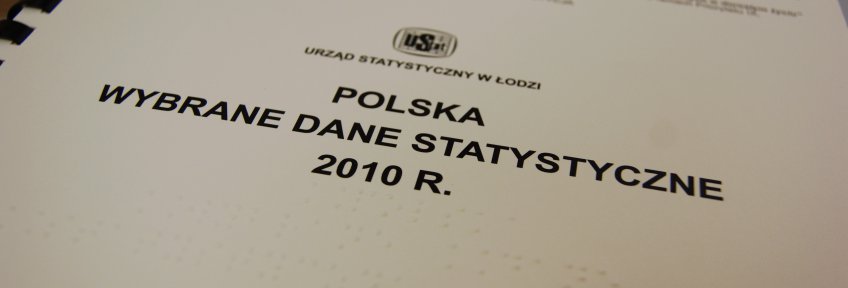The Statistical Office in Łódź has created three volumes of publications of extensive statistical data (graphs, tables, etc.) in Braille version on a variety of topics, to create the opportunity of statistical education of blind children and youth.
Now the publication is published on the internet to make an opportunity for educational institutions for blind children and youth to download and duplicate it limitless.
Innovation Summary
Innovation Overview
One of the unique educational activities undertaken by the Statistical Office in Łódź was the preparation of a statistical publication written in Braille - "Poland - selected statistical data". The study was created in cooperation with the Special School and Educational Center No. 6 in Łódź.
The publication was published in December 2011 in Łódź, it contains three volumes and statistical issues related to culture, education, tourism, migration and the study of economic activity of the population. It was also printed in the so-called Big-Black-Letters - for young people who do not see well.
Preparation of materials to work with students was one of the activities carried out as part of the project co-financed by the European Union from the European Social Fund.
The activity undertaken by the Statistical Office in Łódź was aimed at shaping the skills of collecting, processing, interpreting and using statistical data.
The publication was dedicated to a specific group of recipients - people with difficulties of the access to common information channels. It was a response for the needs of students with special educational needs. The publication is available for download on the Office's www portal, which allows its use by any educational institution.
Innovation Description
What Makes Your Project Innovative?
The publication is based on adaptation of tables and graphics containing statistical data to the Braille language. Printing on a special thermal-sensitive paper and then usage of heating engine to make the printed material convex, allowed to obtain the finger-perceptible didactic material.
There were a lot of details which were necessary to apply such as several line thicknesses or appropriate distances between elements of the side.
What is the current status of your innovation?
The publication was completed and printed in 2011. After printing it was transferred to the Special Educational Center in Łódź - the school which has been cooperating with the Statistical Office in Łódź during the EU project, which enabled the creationof the publication. The study is used during education of blind children and youth now.
In addition, the publication has been published on the Office's website in electronic form, so that after downloading, it may be limitless printed and adapted by educational institutions.
In the Statistical Office in Łódź, the elaboration is used during apprenticeships for the not fully seeing youth
Innovation Development
Collaborations & Partnerships
1. Special Educational Center No. 6 in Łódź – the school for blind children. The teachers from this school helped to adapt the publication into the Braille language.
2. The Special Education Center for Blind Children in Laski – the Center supported the Statistical Office in Łódź to eliminate defects in the publication.
3. Braille language experts.
Users, Stakeholders & Beneficiaries
The beneficiaries of the project were children and youth from educational institutions for blind. The institutions were able to download the publication from the Internet and duplicate it limitless.
Innovation Reflections
Results, Outcomes & Impacts
After preparing the publication the possibility of statistical education occurred.
The employees of Statistical Office, involved in statistical education, has now an opportunity to work with blind children. There was no such an opportunity before.
There were no this kind of publication before in Poland and in whole Europe (to our knowledge).
Challenges and Failures
The employees of the Statistical Office in Łódź were obliged to get to know the rules of Braille language.
The problem was also the cost of the special thermal-sensitive paper. The thermal-paper often got damaged after putting it in the heating engine.
Another problem was the volume, size of the publication. Only several statistical topics generated many pages, therefore the publication had to be divided in 3 parts.
Conditions for Success
The success of this kind of innovation depends most of all on the accuracy of the realization of publication. Every line, shape and space are very important to enable the blind society to use the most of it.
The financial resources are also desirable, because of the costs of the special thermal-paper.
It was very important to have the involvement of Braille experts and qualified and motivated human resources.
Replication
The study is used during education of blind children and youth now.
In addition, the publication has been published on the Office's website in electronic form, so that after downloading, it may be limitless printed and adapted by educational institutions.
Lessons Learned
The publication created by the Statistical Office in Łódź was aimed at shaping the skills of collecting, processing, interpreting and using statistical data. It helped in the educational proces of many young people.
Anything Else?
The creators of the publication recommend to everybody to create a product that will be useful for a specific group of recipients and will generate so many positive and useful experiences. The reaction of blind children and youth as much as the information feedback from the school was an award in itself for the creators of the publication.
Status:
- Implementation - making the innovation happen
- Evaluation - understanding whether the innovative initiative has delivered what was needed
Date Published:
5 November 2011


